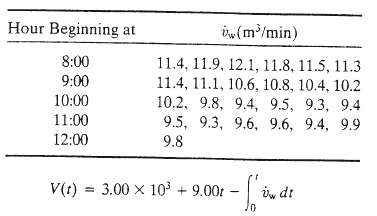A gas storage tank with a floating roof receives a steady input of 540 m3/h of a
Question:
A gas storage tank with a floating roof receives a steady input of 540 m3/h of a natural gas. The rate of withdrawal of gas from the tank, vw, varies more or less randomly during the day and is recorded at 10-mm intervals. At 8:00 a.m. one morning the volume of stored gas is 3.00 x 103 m3. The withdrawal rate data for the next 4 hours are as follows: The temperature and pressure of the inlet, stored, and outlet gases are equal and nearly constant throughout the given time period.
(a) Write a differential balance on the moles of gas in the tank, and prove that when integrated it yields the following equation for the gas volume: where t(min) is the time elapsed since 8:00 am.
(b) Calculate the stored gas volume at noon, using Simpson's rule (Appendix A.3) to evaluate the integral.
(c) Although a running estimate of the tank volume is important to have, in practice it would probably not be obtained in the manner indicated. How would it be obtained? What might you infer if the value estimated in part (b) is greater than that obtained by the more accurate method?
(d) Create a spreadsheet or a computer program to read in the data for vw (t) and to estimate and print out the gas volume at each time for which vw is recorded, using the trapezoidal rule (Appendix A.3) to evaluate the integral over each successive 10-mm interval. What is the percentage difference between the volumes at noon estimated by Simpson's rule and the trapezoidal rule? Which estimate should be moreaccurate?

Step by Step Answer:

Elementary Principles of Chemical Processes
ISBN: 978-0471720638
3rd Edition
Authors: Richard M. Felder, Ronald W. Rousseau





